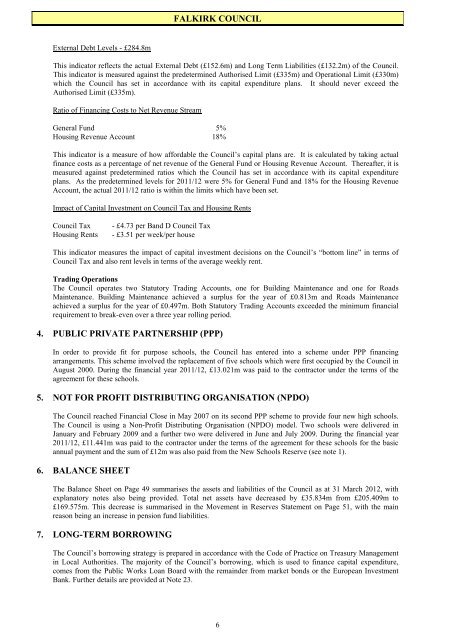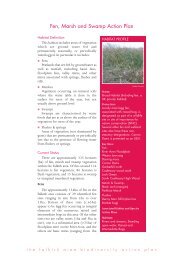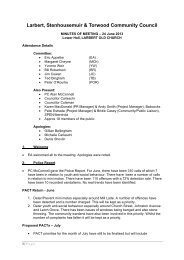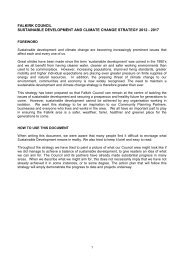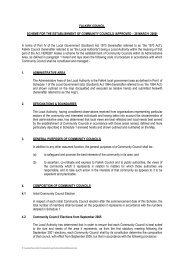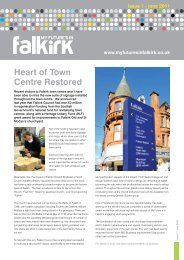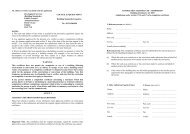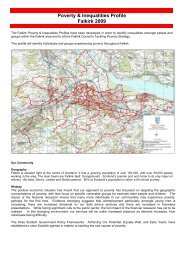2011/2012 audited annual accounts - Falkirk Council
2011/2012 audited annual accounts - Falkirk Council
2011/2012 audited annual accounts - Falkirk Council
Create successful ePaper yourself
Turn your PDF publications into a flip-book with our unique Google optimized e-Paper software.
External Debt Levels - £284.8m<br />
FALKIRK COUNCIL<br />
This indicator reflects the actual External Debt (£152.6m) and Long Term Liabilities (£132.2m) of the <strong>Council</strong>.<br />
This indicator is measured against the predetermined Authorised Limit (£335m) and Operational Limit (£330m)<br />
which the <strong>Council</strong> has set in accordance with its capital expenditure plans. It should never exceed the<br />
Authorised Limit (£335m).<br />
Ratio of Financing Costs to Net Revenue Stream<br />
General Fund 5%<br />
Housing Revenue Account 18%<br />
This indicator is a measure of how affordable the <strong>Council</strong>’s capital plans are. It is calculated by taking actual<br />
finance costs as a percentage of net revenue of the General Fund or Housing Revenue Account. Thereafter, it is<br />
measured against predetermined ratios which the <strong>Council</strong> has set in accordance with its capital expenditure<br />
plans. As the predetermined levels for <strong>2011</strong>/12 were 5% for General Fund and 18% for the Housing Revenue<br />
Account, the actual <strong>2011</strong>/12 ratio is within the limits which have been set.<br />
Impact of Capital Investment on <strong>Council</strong> Tax and Housing Rents<br />
<strong>Council</strong> Tax - £4.73 per Band D <strong>Council</strong> Tax<br />
Housing Rents - £3.51 per week/per house<br />
This indicator measures the impact of capital investment decisions on the <strong>Council</strong>’s “bottom line” in terms of<br />
<strong>Council</strong> Tax and also rent levels in terms of the average weekly rent.<br />
Trading Operations<br />
The <strong>Council</strong> operates two Statutory Trading Accounts, one for Building Maintenance and one for Roads<br />
Maintenance. Building Maintenance achieved a surplus for the year of £0.813m and Roads Maintenance<br />
achieved a surplus for the year of £0.497m. Both Statutory Trading Accounts exceeded the minimum financial<br />
requirement to break-even over a three year rolling period.<br />
4. PUBLIC PRIVATE PARTNERSHIP (PPP)<br />
In order to provide fit for purpose schools, the <strong>Council</strong> has entered into a scheme under PPP financing<br />
arrangements. This scheme involved the replacement of five schools which were first occupied by the <strong>Council</strong> in<br />
August 2000. During the financial year <strong>2011</strong>/12, £13.021m was paid to the contractor under the terms of the<br />
agreement for these schools.<br />
5. NOT FOR PROFIT DISTRIBUTING ORGANISATION (NPDO)<br />
The <strong>Council</strong> reached Financial Close in May 2007 on its second PPP scheme to provide four new high schools.<br />
The <strong>Council</strong> is using a Non-Profit Distributing Organisation (NPDO) model. Two schools were delivered in<br />
January and February 2009 and a further two were delivered in June and July 2009. During the financial year<br />
<strong>2011</strong>/12, £11.441m was paid to the contractor under the terms of the agreement for these schools for the basic<br />
<strong>annual</strong> payment and the sum of £12m was also paid from the New Schools Reserve (see note 1).<br />
6. BALANCE SHEET<br />
The Balance Sheet on Page 49 summarises the assets and liabilities of the <strong>Council</strong> as at 31 March <strong>2012</strong>, with<br />
explanatory notes also being provided. Total net assets have decreased by £35.834m from £205.409m to<br />
£169.575m. This decrease is summarised in the Movement in Reserves Statement on Page 51, with the main<br />
reason being an increase in pension fund liabilities.<br />
7. LONG-TERM BORROWING<br />
The <strong>Council</strong>’s borrowing strategy is prepared in accordance with the Code of Practice on Treasury Management<br />
in Local Authorities. The majority of the <strong>Council</strong>’s borrowing, which is used to finance capital expenditure,<br />
comes from the Public Works Loan Board with the remainder from market bonds or the European Investment<br />
Bank. Further details are provided at Note 23.<br />
6


